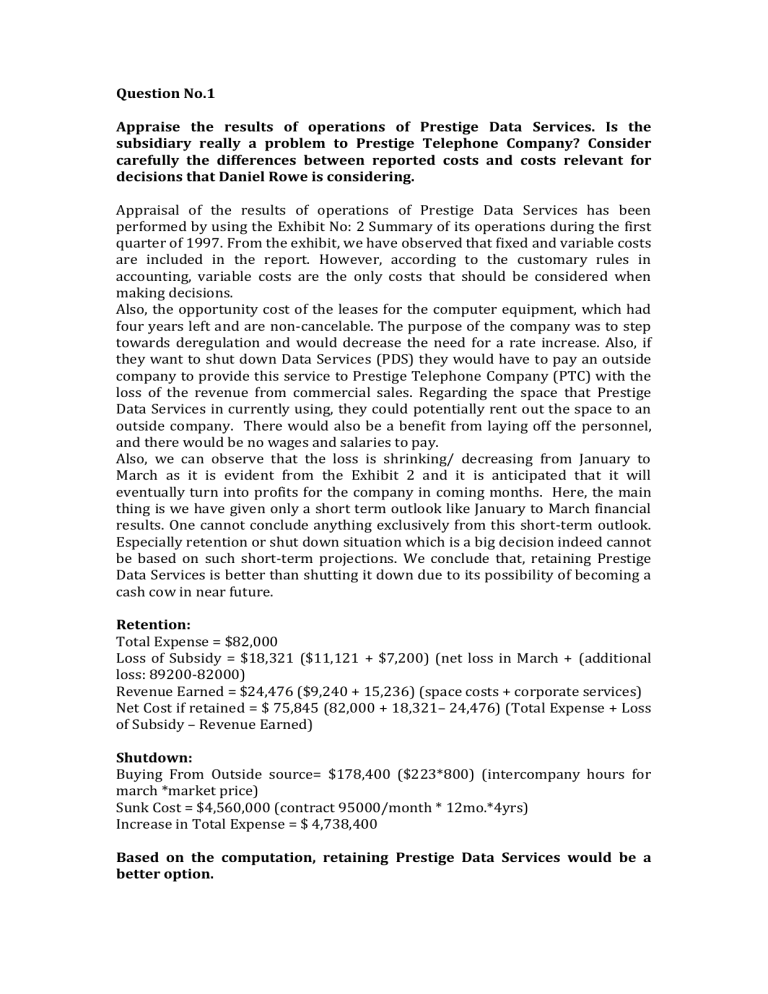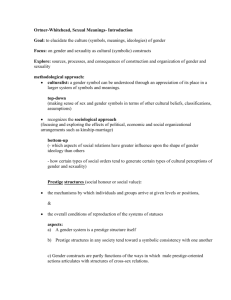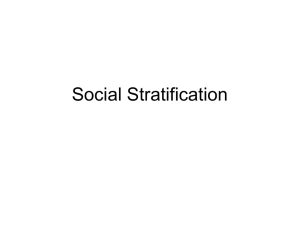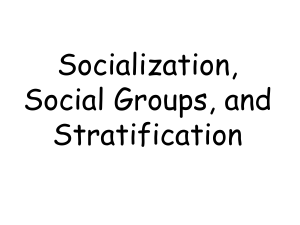
Question No.1 Appraise the results of operations of Prestige Data Services. Is the subsidiary really a problem to Prestige Telephone Company? Consider carefully the differences between reported costs and costs relevant for decisions that Daniel Rowe is considering. Appraisal of the results of operations of Prestige Data Services has been performed by using the Exhibit No: 2 Summary of its operations during the first quarter of 1997. From the exhibit, we have observed that fixed and variable costs are included in the report. However, according to the customary rules in accounting, variable costs are the only costs that should be considered when making decisions. Also, the opportunity cost of the leases for the computer equipment, which had four years left and are non-cancelable. The purpose of the company was to step towards deregulation and would decrease the need for a rate increase. Also, if they want to shut down Data Services (PDS) they would have to pay an outside company to provide this service to Prestige Telephone Company (PTC) with the loss of the revenue from commercial sales. Regarding the space that Prestige Data Services in currently using, they could potentially rent out the space to an outside company. There would also be a benefit from laying off the personnel, and there would be no wages and salaries to pay. Also, we can observe that the loss is shrinking/ decreasing from January to March as it is evident from the Exhibit 2 and it is anticipated that it will eventually turn into profits for the company in coming months. Here, the main thing is we have given only a short term outlook like January to March financial results. One cannot conclude anything exclusively from this short-term outlook. Especially retention or shut down situation which is a big decision indeed cannot be based on such short-term projections. We conclude that, retaining Prestige Data Services is better than shutting it down due to its possibility of becoming a cash cow in near future. Retention: Total Expense = $82,000 Loss of Subsidy = $18,321 ($11,121 + $7,200) (net loss in March + (additional loss: 89200-82000) Revenue Earned = $24,476 ($9,240 + 15,236) (space costs + corporate services) Net Cost if retained = $ 75,845 (82,000 + 18,321– 24,476) (Total Expense + Loss of Subsidy – Revenue Earned) Shutdown: Buying From Outside source= $178,400 ($223*800) (intercompany hours for march *market price) Sunk Cost = $4,560,000 (contract 95000/month * 12mo.*4yrs) Increase in Total Expense = $ 4,738,400 Based on the computation, retaining Prestige Data Services would be a better option. Question No: 2 Assuming the company demand for service will average 205 hours per month, what level of commercial sales of computer use would be necessary to break even each month? For calculating the level of commercial sales of computer use, we need to determine fixed and variable costs. The only variable costs were power and part of operations salaries. The total power cost for all three months is = ($1633+ $1592+$1803) = $5028 The computers were is use for 1110 hours So, the Variable cost – Powers Cost per hour = $5028/ 1110 hours = $4.53 Total operations expense = $88,944 Total hours of computer use = 1110 hours So, the variable cost – operations wages is = $88944/ 1110 = $80.13 Here, the contribution margin is = (Selling Price – Variable cost per unit) = $800 – ($4.53 + $80.13) = $715.34 According to the case study, Prestige Telephone Company has an agreement with the Prestige Data Service to cover $82,000 of the costs. Using this assumption and that mentioned in the above paragraph, we have calculated the following break-even analysis= Total Fixed Costs – (Cost Covering by PTC – Average monthly hours X Variable cost per unit) / Contribution Margin= 191,037 – (82000- 205 X84.66) / 715.34 = 126,392.30 / 715.34 = 176.69 (estimated) hours Taking 176.69 hours times the $800 per hour for commercial sales would result in break even revenue of $141,352 that would be necessary each month. Question No: 3 Estimate the effect on income of each of the options Rowe has suggested if Bradley estimates as follows: a. Increasing the price to commercial customers to $1000 per hour would increase demand by 30 percent. Increasing price to commercial customers to $1000 per hour would reduce demand by 30%. From the case study, we have learnt that in March 1997, commercial demand was for 138 hours, and a 30% reduction would leave demand of 97 hours (138 hours X 0.70 = 96.6 hours) So, Demand X Contribution per Hour = $1000- ($84.66 X 96.6 hours) = $915.34 X 96.6 hours =$88,421.85 (Estimated) Compare to Present: 138 hours X ($800-$84.66) = $98,716.92 The monthly contribution to fixed costs and income at $800 is greater than by $10,295.07 than the contribution expected at $1000. Therefore, the income will be higher if we retain that $800/ hour price. b. Reducing the price to commercial customers to $600 per hour would increase demand by 30 percent. Reducing the price to commercial customers to $600 per hour would increase demand by 30%. In March 1997, commercial demand was 138 hours, so that a 30% increase would give demand of 179.4 hours (138 hours X 1.30 = 179.4 hours) So, 179.4 hours X ($600- $84.66) = $92,451.70 (estimated) Compared to present contribution of $98,716.92, a price reduction would apparently reduce profit by $6265.22 per month. c. Increased promotion would increase sales by up to 30 percent. Bradley is unsure how much promotion this would take. An increase in promotion that would increase commercial sales by 30% would increase sales to 179.4 hours per month. At $800 per hour, the total contribution would be- 179 hours X ($800 – $84.66) = $128,045.86 An amount up to the difference between this new contribution and the present contribution of $98,716.92 or $ 29,328.94 could be spent without reducing income. d. Reducing operations to 16 hours on weekdays and eight hours on Saturdays would result in a loss of 20 percent of commercial revenue hours. Reducing hours would reduce demand for revenue hours by 20%, from 138 hours to 110 (138 hours X 0.80 = 110 hours) hours. At that level, the total contribution would be, 110 hours X ($800-$84.66) = 110 hours X $ 715.34 = $78,687.40 So, it is ($98,716.92 -$78,687.40) = $20,029.52 at present. Now question comes what expenses could be saved? Except for wages and perhaps materials and supplies, it appears most other expenses would not be affected by this reduction of service and revenue. Question No: 4 Can you suggest changes in the accounting and reporting system now used for operations of Prestige Data Services, which would result in more useful information for Rowe and Bradley? We would like to suggest Prestige Data services to use consolidated financial statements for the parent and subsidiaries as these statements will show the true contribution that the Prestige Data Service is providing for Prestige Telephone Company. There are certain costs within Prestige Date that benefit the parent company but they are only being seen as expenses to Prestige Data Services and are not showing how these services are providing revenue for Prestige Telephone Company. So, when making decisions Prestige Data Services should consider the variable costs and not just all reported costs.




